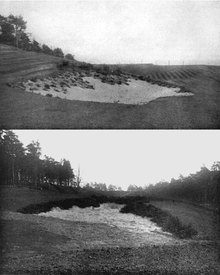Harry Colt
Henry Shapland "Harry" Colt (4 August 1869 – 21 November 1951) was a golf course architect born in Highgate, England. He worked predominantly with Charles Alison, John Morrison, and Alister MacKenzie, in 1928 forming Colt, Alison & Morrison Ltd. He participated in the design of over 300 golf courses (115 on his own) in North America, South America, Europe, Australia, Asia, and Africa. Colt's courses of note in the UK include: Tandridge Golf Club, Oxford Golf Club, Ladbrook Park Golf Club, Denham Golf Club, St George's Hill, Sunningdale (New course), Belfairs Golf Club, Rye, Blackmoor, Swinley Forest, Brancepeth Castle, Brokenhurst Manor, Camberley Heath, Stoke Park Club, Calcot Park, Goring and Streatley Golf Club, Grimsby Golf Club, Hendon Golf Club, Tyneside and the East & West Courses at Wentworth Club. He performed extensive redesigns of Sunningdale (Old course), Woodhall Spa, and of Muirfield, Royal Liverpool Golf Club, Hoylake, and Royal Portrush, three of the courses on the rota for the Open Championship. In Canada, his courses for the Hamilton Golf and Country Club and the Toronto Golf Club are highly respected. He also designed in 1914 the first Spanish course bigger than 4.300 yards, the Club de Golf Sant Cugat, promoted by the Barcelona Traction Light and Power Company Ltd. While it is often joked that "the sun never sets" on a course designed by architect Robert Trent Jones, this is actually true for the works of Colt and his collaborators.

H.S Colt teamed up with George Crump in 1918 to design Pine Valley Golf Club, which is ranked the #1 Golf Course in the United States, as of April 2017. The classic Plum Hollow Country Club in Southfield, Michigan was designed by Colt and Alison in 1921. The course played host to the 1947 PGA Championship, the 1957 Western Open, and Ryder Cup Challenge Matches in 1943.
Colt was educated at Monkton Combe School near Bath [1] before taking a law degree at Clare College, Cambridge,[2] where he captained the Cambridge University Golf Club in 1890.
In 1897 he became a Founder Member of the Royal & Ancient Rules of Golf Committee.
Results in major championships
Note: Colt played in only The Open Championship and The Amateur Championship.
| Tournament | 1891 | 1892 | 1893 | 1894 | 1895 | 1896 | 1897 | 1898 | 1899 |
|---|---|---|---|---|---|---|---|---|---|
| The Open Championship | T38 | DNP | DNP | DNP | DNP | DNP | DNP | DNP | DNP |
| The Amateur Championship | DNP | DNP | DNP | DNP | R64 | R32 | R32 | R64 | R32 |
| Tournament | 1900 | 1901 | 1902 | 1903 | 1904 | 1905 | 1906 | 1907 | 1908 | 1909 |
|---|---|---|---|---|---|---|---|---|---|---|
| The Amateur Championship | R32 | QF | R64 | DNP | R64 | DNP | SF | R128 | QF | R128 |
| Tournament | 1910 | 1911 | 1912 |
|---|---|---|---|
| The Amateur Championship | R32 | QF | R32 |
DNP = Did not play
"T" indicates a tie for a place
R128, R64, R32, R16, QF, SF = Round in which player lost in match play
Yellow background for top-10
Source for 1895 British Amateur: The Glasgow Herald, 8 May 1895, pg. 8.
Source for 1896 British Amateur: The Glasgow Herald, 21 May 1896, pg. 11.
Source for 1898 British Amateur: The Glasgow Herald, 25 May 1898, pg. 10.
Source for 1899 British Amateur: The Glasgow Herald, 25 May 1899, pg. 11.
Source for 1900 British Amateur: The Glasgow Herald, 10 May 1900, pg. 13.
Source for 1901 British Amateur: Golf, June 1901, pg. 413.
Source for 1902 British Amateur: The Glasgow Herald, 30 April 1902, pg. 10.
Source for 1904 British Amateur: The Glasgow Herald, 1 June 1904, pg. 11.
Source for 1906 British Amateur: Golf, July 1906, pg. 30.
Source for 1907 British Amateur: The Glasgow Herald, 29 May 1907, pg. 12.
Source for 1908 British Amateur: The Glasgow Herald, 29 May 1908, pg. 14.
Source for 1909 British Amateur: The American Golfer, July 1909, pg. 11.
Source for 1910 British Amateur: The Glasgow Herald, 2 June 1910, pg. 8.
Source for 1911 British Amateur: The Glasgow Herald, 2 June 1911, pg. 9.
Source for 1912 British Amateur: The American Golfer, July 1912, pg. 198.
Team appearances
- England–Scotland Amateur Match (representing England): 1908
References
- http://www.bathgolfclub.org.uk/harrycolt.php
- "Colt, Henry Shapland (CLT887HS)". A Cambridge Alumni Database. University of Cambridge.
External links
- Colt Association Official Site
- Oxford Dictionary of National Biography article by Mark Pottle, ‘Colt, Henry Shapland [Harry] (1869–1951)’ accessed 2 March 2007
- Bath Golf Club Official Site